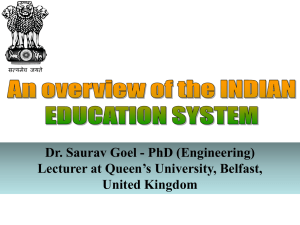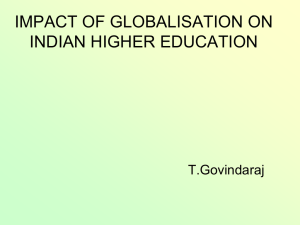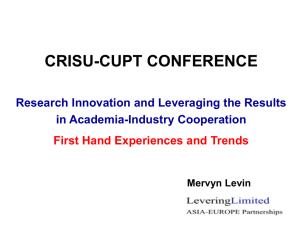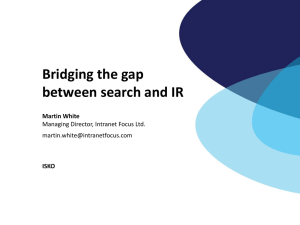Tamil Unicode - India Today Group
advertisement
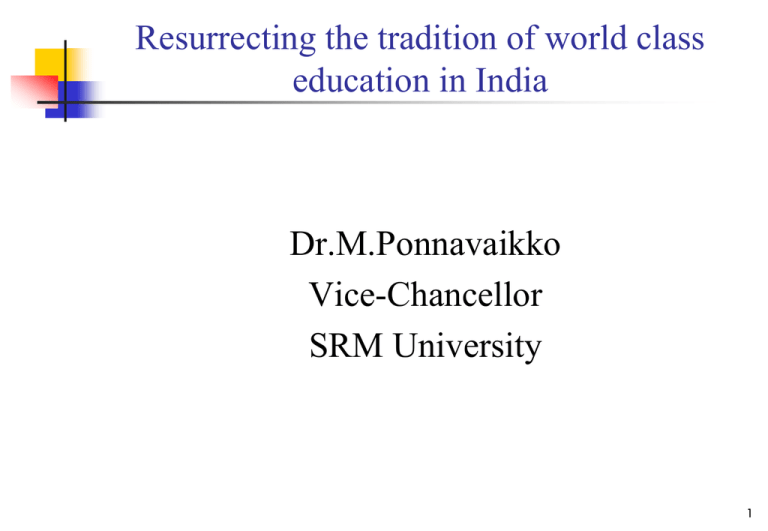
Resurrecting the tradition of world class education in India Dr.M.Ponnavaikko Vice-Chancellor SRM University 1 Aim of Higher Education Purpose of Higher Education should be to develop an individual as a useful Human Resource with the following traits: Knowledge through relevant Curriculum, Skill for empowerment, Ethical Values to function as a Human being, As a whole to develop a Human Resource, useful to oneself and to the community. 2 World class Education - Definition Although the term “World Class Education” has been used widely in conversations about academic institutions, there has been little attempt to define the term carefully. Woe d not have an operational definition for the term “world class education”, As per web definition : World class education is “Non-competitive system based on national standards and benchmarks that match international standards that students must embrace as a common set. 3 World Class University Great universities have three major roles: 1. Excellence in education of their students; 2. Research, development and dissemination of knowledge; and 3. Activities contributing to the cultural, scientific, and civic life of society. 4 Excellence in education By excellence in education, we refer to the resources and organization of undergraduate, graduate, and professional instruction and educational opportunities for students. Clearly, this goal requires outstanding faculty, high quality teaching and other instructional activities, and availability of good libraries, laboratories, and other pertinent facilities as well as highly prepared and motivated students who serve to educate through their peer influence. 5 Research &development Research, development, and dissemination of knowledge refer to the embryonic identification, growth, and extension of concepts and ideas as well as Their transformation into applications, goods, and services that enhance understanding and welfare. 6 Cultural, Scientific, and Civic life Activities contributing to the cultural, scientific, and civic life of society are many and varied, but include conferences, publications, artistic events and forums as well as provision of services that engage and contribute to the larger community including the regional, national, and international communities. 7 Benchmarks Typical benchmarks referred to are publications to and citations of faculty as well as the devotion of the university to research activities. Other foci include Academic freedom, facilities, funding, diversity of faculty, students, and fields of study Including internalization of students, staff and curriculum. Competition for faculty and students as well as selection of the most talented students, teaching quality, and connection to society 8 Purpose of Education in different civilization During the primitive cultures the term education meant enculturation, which is the process of cultural transmission. Thus, the purpose of primitive education was to guide children to become good members of their tribe or band, giving emphasis upon training for citizenship. During the first civilization phase (3000–1500 BC), the writing and formal education system was made indispensable. 9 Mesopotamian education Mesopotamia developed education with respect to its purpose and training. Formal education was practical and aimed to train scribes and script. It was extended from basic reading, writing, and religion to higher learning in law, medicine, and astrology. Generally, youth of the upper classes were prepared to become scribes, who ranged from copyists to librarians and teachers. The schools for priests were said to be as numerous as temples. This indicates the thoroughness and the supremacy of priestly education. 10 Mesopotamian education The centre of intellectual activity and training was the library, which was usually housed in a temple under the supervision of influential priests. Methods of teaching and learning were memorization, oral repetition, copying models, and individual instruction. The period of education was long and rigorous, and discipline was harsh. 11 Ancient Indian Education India is one of the most ancient civilizations in the world. The Indo-European-speaking people entered India in the 2nd millennium BC and established large-scale settlements and founded powerful kingdoms. In the course of time, a group of intellectuals, the Brahmans, became priests and men of learning. During the first period, the child received elementary education at home. 12 Ancient Indian Education The beginning of secondary education and formal schooling was marked by a ritual known as the upanayana The boy would leave his father’s house and enter his preceptor’s ashrama, a home situated amid sylvan surroundings. The acarya would treat him as his own child, give him free education, and not charge anything for his boarding and lodging. 13 Ancient Indian Education The study at this stage consisted of the recitation of the Vedic mantras and the auxiliary sciences—phonetics, the rules for the performance of the sacrifices, grammar, astronomy, prosody, and etymology. The period of studentship normally extended to 12 years. For those who wanted to continue their studies, there was no age limit. This is how the Guru-Sishya system of education started in India. 14 Birth of University Education The 500 years from the 4th century AD to the close of the 8th, under the Guptas and Harsha and their successors, is a remarkable period in Indian history. It was the age of the universities of Nalanda and Valabhi and of the rise of Indian sciences, mathematics, and astronomy. The university at Nalanda housed a population of several thousand teachers and students. Because of its fame, Nalanda attracted students from abroad, but the admission test was so strict that only two or three out of 10 attained admission. 15 Nalanda University More than 1,500 teachers discussed more than 100 different dissertations every day. These covered the Vedas, logic, grammar, Buddhist and Hindu philosophy , astronomy, and medicine. 16 Gurukul Education Nearly every village had its schoolmaster, who was supported from local contributions. The Hindu schools of learning, known as pathasalas were conducted by Brahman acaryas at their residence. Each imparted instruction in an advanced branch of learning and had a student enrollment of not more than 30. Larger or smaller establishments, specially endowed by rajas and other donors for the promotion of learning, also grew in number. 17 Influence of Indian Education outside India Indian education during the ancient period had a great influence on the culture of Sri Lanka and Central and Southeast Asia. A number of Indian scholars lived there, and many Chinese pilgrims remained there instead of going to India. Indian pandits (scholars) were also invited to China and Tibet, and many Chinese and Tibetan monks studied in Buddhist viharas in India. 18 Indian Education The Gurukul Education continued in India until the Industrial Civilization was dawn. During the Industrial civilization the formal Class room type of education was started. Later to meet the large demand of trained manpower Distance Education system was introduced. During the period of British rule Universities like Calcutta, Bombay and Madras Universities were started based on British pattern. 19 Indian Education Even after independence our system of education, including curriculum and syllabi are based on the western universities. The local needs are not addressed. During early 1980s Education was privatized in India. Many privately funded universities like SRM Universities are doing well. 20 Higher Education for Empoerment India is not a poor country, But, a country with poor people. India ranks11th in GDP (1,235,975 million USD) India ranks fourth in PPP (3,526,124 million USD) But, India ranks 142nd with a per capita GDP of 1032. India ranks 129th with a per capita PPP of US$2,900 one-third of the poor people, living bellow poverty line in the world, reside in India. 70% of the Population live in Rural India. 21 Does Higher Education Help in Reducing the Poverty level ? (1) Indian Universities Produce Graduates for the developed World. Rural India is Agro based with a cultivable area of 1,269,219 km² India has a total water surface area of 314,400 km² and receives an average annual rainfall of 1,100 mm. It also has the world's largest cattle population: 193 million India is the largest producer in the world of milk 22 Does Higher Education Help in Reducing the Poverty level ? (2) It is the second largest producer of wheat, rice, sugar, cotton, silk, pe.anuts and inland fish It is the third largest producer of tobacco. India is the largest fruit producer, accounting for 10% of the world fruit production. India is the second largest producer of silk. Medicinal Plants grow in the Tribal areas All of the above happen in Rural and Tribal India. What is the Industrial concentration in Rural India? 23 Does Higher Education Help in Reducing the Poverty level ? (3) Does the Curricula of Indian Universities address the exploitation of these Rural and Tribal Resources? Are there skill development components in the curriculum ? Are there Higher Education Institutions in the Rural areas? Whether the Universities have specially designed academic programs to empower the Rural mass for establishing their own house hold industries using the local Resources and Raw materials? 24 Issues of Higher Education Inadequate Institutions to provide access to 144.287 million persons in the age group of 18-23 years during 2011-12 for higher education. Uneven Distribution of Institutions among the Urban and Rural areas. Diminishing rate of funding on higher education by the Government year by year in the Govt. Institutions. High cost of Higher Education that limits the poor to access Higher Education,. Inadequate Facilities and Facilities in the Institutions 25 Poor qualities of Teaching and Learning Process Issues of Higher Education (1) It is an irony in India that the bureaucracy restricts the modernization and expansion of higher education by private players intended to impart quality education. At the same time a large number of institutions without having adequate infrastructure and offering substandard education are not only surviving but also flourishing. Not more than 15 percent of graduates of general education and 25-30 percent of Technical Education are fit for employment. 26 Issues of Higher Education (2) Lack of Skill based curricula in Higher Education. Lack of entrepreneurship based curricula in Higher Education. Lack of Human Values in Higher Education curricula. Lack of Personality Development aspects in Higher Education curricula. 27 Policy Issues of Higher Education (3) On the Government’s Educational Policy Framework: (i) Is the policy Framework catering to the diversity of the Indian Education Sector ? (ii) Is the Education Policy Framework conducive to investment in the Sector ? (iii) Do the Education Policies encourage autonomy along with accountability ? (iv) Does the policy Framework encourage PPP model in education initiatives ? 28 Quality Issues in Higher Education Inadequate infrastructural facilities. Not up to date laboratory equipments and facilities. Inadequate and Inappropriate Teachers. Inadequacy in fixing the minimum requirement criteria for the appointment of Teachers in the Higher Education Institutions. Inadequate use of latest Technology and Pedagogies in the Teaching and Learning Process. Lack of Training Schemes for the Teachers. 29 Scientific Research for Economic Development Scientific Research in the Universities should be appropriate to the local conditions. Research should provide tools and methods for transforming the Natural Resources of the country into products , useful to the community. India being an Agro based country, with a large area for cultivation, spread over Rural India, University Research should concentrate in developing appropriate Technology for enriching the Rural economy. 30 Problems and Issues of Research in the Universities (1) Purpose of most of the Ph.D. Research in the Universities and colleges is to obtain Ph.D. degree for getting a teaching job. Hence it is commercialized. To promote Research activities among the teaching faculties in the Universities, it is propagated as to “Publish or Perish.” Because of that, the Researchers Publish, get their degree, but do not produce products. Such research do not benefit the community and thus, they “Publish and Perish.” 31 Problems and Issues of Research in the Universities (2) Many of the Privately funded Universities offer Ph.D. Research programs with out having qualified Guides. They appoint Professors of State or Central Universities/ IITs as Guides for their full time candidates. In this process a Professor in a State University becomes a Guide to many Private Universities, in the name of External Guide, with no limit on the number of Research scholars to guide. The irony is that they say that it is permitted by UGC. 32 Solutions To achieve greater Access, justified Equity and Excellent Quality in Higher Education, the Academic Institutions should Encourage Good Institutions with controlled freedom. In the case of such institutions, run without having adequate infrastructure and offering substandard education, the Govt. should partner with the management, financially on a true PPP model, and exercise control to regulate A E Q. 33 Solutions A Faculty Training Board should be set up for training those who prefer to become teaching Faculties. The Minimum qualification for the appointment of Faculties in the Universities and colleges, (A pass in NET/SLET Examination) now in vogue in UGC, do not check for the ability to teach. Candidates trained in the Faculty Training Board only should be appointed as teaching Faculties. Skill based components should be included in all the Under Graduate Curricula. 34 Solutions University Research should be made product oriented. Even Fundamental research should aim for an ultimate Product development in the subsequent Research efforts. A full time faculty in one Teaching institution should not be permitted as a guide to a scholar registered as a full time candidate in another teaching institution. The total number of Research scholars registered under a guide, including the part time candidates, should not exceed the limit fixed by UGC. 35 The End Thank You 36
